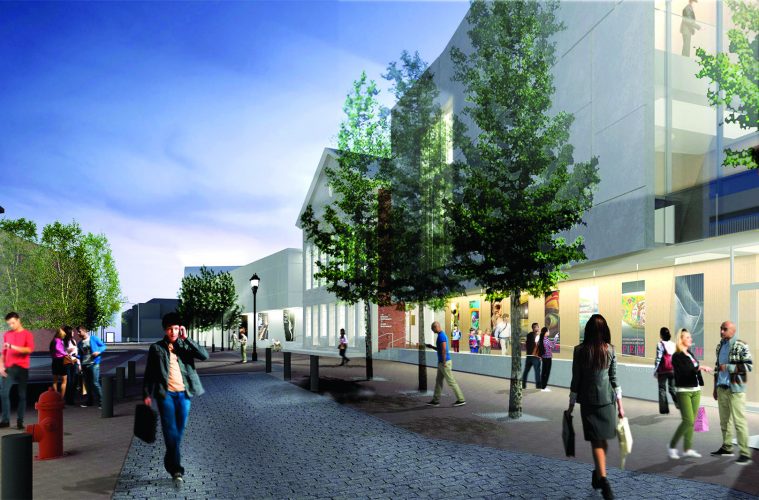When Salem sea captains brought together a diverse collection of objects from their global travels, their vision established a connection between Salem and the rest of the world that has made Salem the eclectic and sophisticated little city/big town it is today.
That was 1799.
When the Peabody Essex Museum (PEM) expanded in 2003 through the vision of world-renowned architect Moshe Safdie, it was the making of modern-day Salem. And once again, museum officials have taken up shiny shovels to break ground. When PEM’s new 40,000-square-foot wing designed by New York City–based Ennead Architects opens to the public in 2019, it will rise three stories along the Essex Street pedestrian way and will rank PEM among the top 20 largest art museums in North America.
As museums around the country build new wings, renovate, expand, and reinstall, the North Shore’s own PEM is reimagining what a museum can and should be. When people hear “art museum,” they tend to think of a visual experience. That’s just one component of what PEM plans to offer in the coming years. Incorporated into new galleries will be sound, smell, and tactile experiences.
“Based on how we navigate the world on a daily basis, we are what we are because of our senses and how our brain processes and experiences things,” says Lynda Roscoe Hartigan, PEM’s James B. and Mary Lou Hawkes deputy director. “The notion of being able to stimulate a variety of senses in an art museum environment is something we’re intrigued by.”
Exploring a museum means navigating not only buildings and galleries, but also various narratives. Hartigan says that PEM leadership is being mindful of whose stories they’re telling, and to whom. “How does a museum move from an anonymous, authoritative voice to something more personalized,” she asks, “from not only museum staff, but from people currently engaged with specific cultures and viewpoints?”
PEM aims to focus on initiatives that have done just this, from bringing in contemporary Native American artists to consult on exhibitions to creating opportunities for people to leave behind an offering in honor of their particular culture.
“We have no patience with the concept of other,” says Hartigan, “It’s about us and connection.”
Since the beginning, PEM has explored the relationship between the global and the local. It seems fitting that the museum has plans to form a global brain trust on museum leadership, while also kicking off a new education initiative for K-12 students designed to develop problem-solving, teamwork, and critical thinking.
“We see a gap in how children are being educated in schools because of financial cutbacks,” says Hartigan. “We’re inspired to explore how a museum of art and culture can help educate, what with our mission of transforming people’s lives. So, why not get in there early and help children begin to understand their place in this world around them?”
A new wing will highlight the oldest part of the museum, the East India Marine Hall. The focus of many a school field trip, with its iconic maritime figureheads and some of the first-collected objects of the East India Marine Society, this National Historic Landmark opened in 1825 with a reading by then President John Quincy Adams, who said: “This hall is as chaste and beautiful a specimen of architecture as our country can exhibit.”
During the latest groundbreaking in December, it was Salem Mayor Kim Driscoll who stood before the East India Marine Hall, emphasizing the ongoing symbiotic relationship between the museum and Salem. She reminded the crowd that downtown Salem’s last “renaissance” was an echo of PEM’s growth, resulting in hundreds of new small businesses, shops, and restaurants.
“I am excited to see how we can leverage the impacts from this project to further add to that forward momentum in our downtown,” she says.
Other improvements will include a new Collection Center that is more than 100,000 square feet, offering ample space for the care and conservation of the museum’s collection. Hartigan, who came to PEM in 2003 as the museum’s first chief curator and became deputy director in 2016, has asked each of the curators to “go shopping” in each other’s collections to create new installations.
The new PEM experience will encourage dialogue between objects in PEM’s collection, allowing for reflection on the “conversations and confrontation,” says Hartigan, that have historically existed between cultures. Chinese and Japanese cultures, for example, can be explored through trade, textiles, ideas, and ongoing understandings and misunderstandings across time.
Recent exhibitions have already challenged ideas about museum-going, offering visitors a taste of the multisensory experience. An Alexander Calder show featured music, modern dancers brought sculpture to life in the recent Rodin exhibition, people could touch and move Theo Jansen’s lifelike Strandbeests while chatting in the gallery with knowledgeable guides, and in another exhibition, fashion lovers could try on contemporary Japanese designs.
While museums have long offered theatre, music, and dance performances, these are often separate, ticketed events. “We’re trying to bring these various creative expressions in concert with the visual,” says Hartigan. “We don’t separate out the senses.”
Peabody Essex Museum
16 Essex St., Salem
978-745-9500

